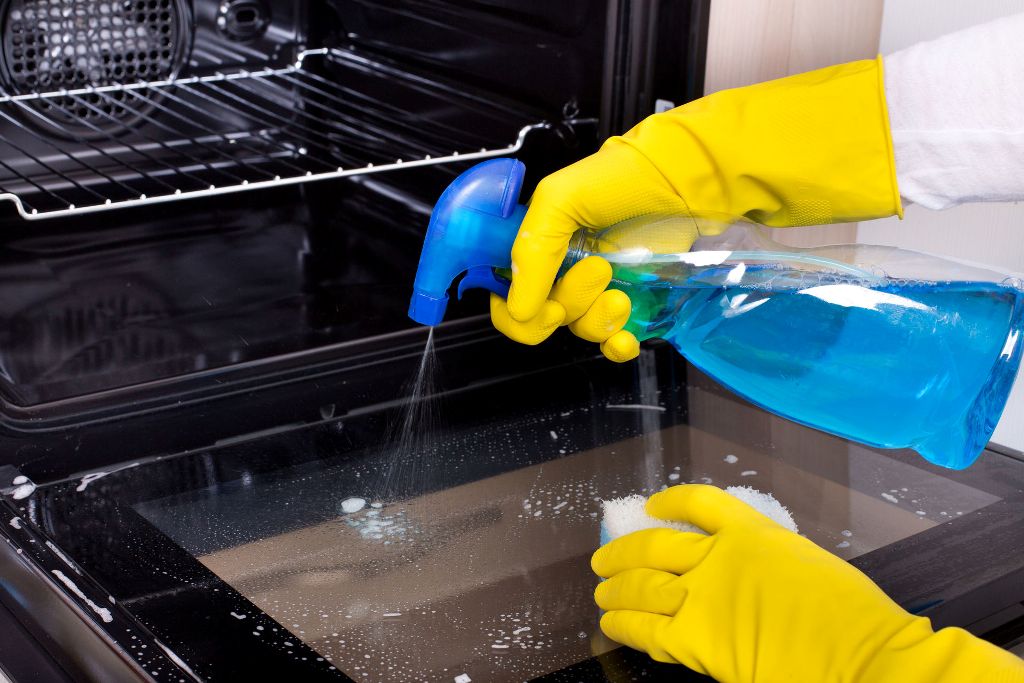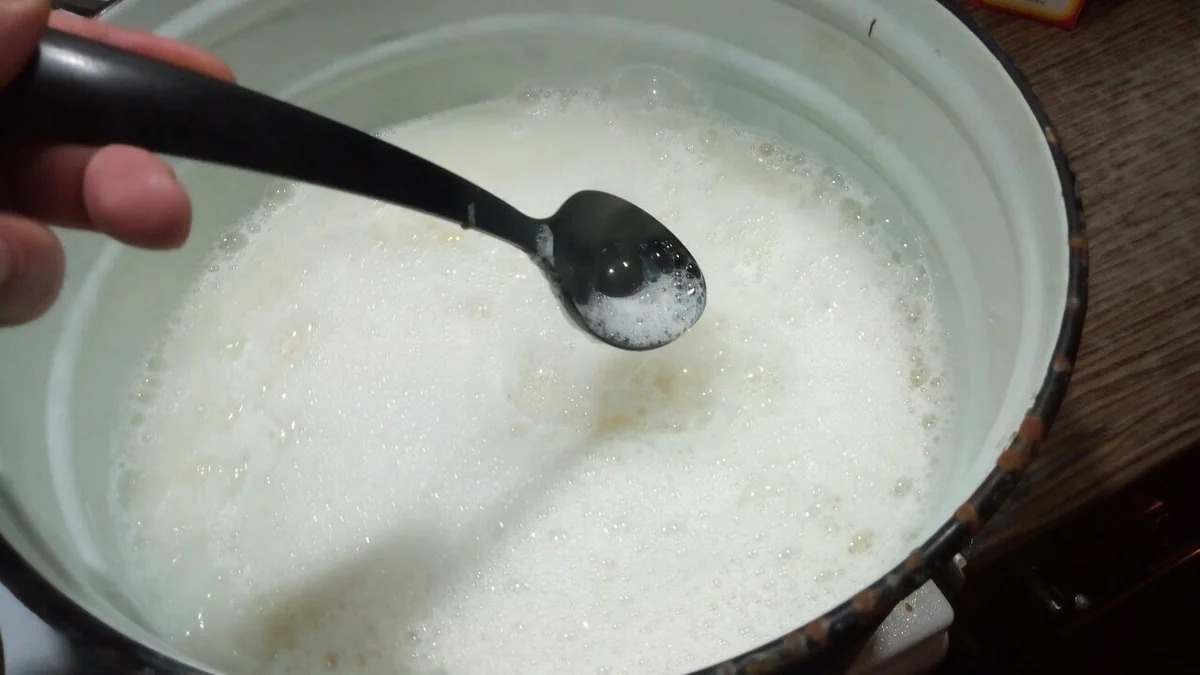We clean the oven from burnt fat and carbon deposits
Any oven sooner or later becomes dirty and covered with a layer of grease. This significantly affects both the quality of food and the operation of the unit itself. Gradually, the plaque begins to burn, which gives the food an unpleasant odor. Therefore, with frequent use of the device, the question of how to clean the oven rather quickly arises. For this, there are both industrial chemicals and proven folk methods.

Special chemicals and folk methods
Both industrial and folk oven cleaners have their pros and cons. So, industrial means allow you to dissolve fat, carbon deposits, soot quite quickly, but they also need to be washed off. After processing with such a product, a characteristic smell remains in the oven, which is very unpleasant. In addition, these products are not environmentally friendly, and their frequent use can cause allergies.

It is interesting that folk remedies: salt, lemon, soda, vinegar and others are based on the same elementary chemical compounds as fashionable industrial preparations. First of all, these are acids and alkalis, which break down fat and dissolve solid compounds in the form of soot, soot and others.

Cleaning the oven using folk methods has many advantages.
- High cheapness of materials
- Materials are always at hand
- Environmental friendliness and harmlessness
- Do not injure surfaces
- You can immediately use the appliance for cooking
Environmental friendliness and safety are especially important for families with small children, the elderly and people with allergies or asthma. In such a family, it is simply impossible and dangerous to use chemicals. Therefore, more and more housewives are choosing folk remedies.

Baking soda and vinegar to remove old burnt fat
Soda and vinegar are antagonistic substances and when they are combined, a violent chemical reaction occurs. As a result, carbon dioxide appears, which aggressively affects fat and destroys it. At the same time, this gas does not have a negative effect on enamel or metals, and therefore, this product is safe for the oven.

The method is worth remembering when the question arises of how to clean the inside of the oven from old fat and a thick layer of carbon. Due to the very active effect of substances, this method manages to clean the oven, when it is difficult to do it with other methods.
Reception has the following sequence:
- Remove all unnecessary items from the oven, including food debris. Prepare a sponge or brush.
- Take 1 part vinegar and 2 parts baking soda, add water or any detergent. Mix the ingredients, they immediately fizzle.

It takes a little effort to get the desired result. - The tool must be quickly applied to the brush and wiped off all surfaces with it.
- After this, the substance must be left in the oven for a while. During this time, the reaction will proceed further, while eating away fat, carbon deposits and other deposits. This usually takes about an hour.

Even old soot on kitchen equipment will be removed without difficulty by this folk remedy. - Just wash the inner surface with a regular sponge dipped in water. You do not need to use any additional tools.
- Another use is to first wipe all surfaces with vinegar, and then sprinkle them with baking soda or wipe with a slurry of baking soda and water.

Before this action, it is recommended to wipe all areas with greasy spots with a damp sponge so that the soda can "stick" to them.
Important! When cleaning the oven, do not use metal brushes - they will scratch enamel or metal. As a result, the device will quickly become unusable. Rust will appear on the metal, and the enamel will begin to crumble.
Lemon oven treatment
Another easy way to remove grease and deposits from the oven is to use lemon. Lemon can be replaced with citric acid in granules, which is sold in any hardware or grocery store.

Application options for the product:
The easy way
- Squeeze lemon juice, moisten a sponge or apply citric acid solution to it. The solution is prepared at the rate of ½ sachet per glass of water.
- Wipe thoroughly all contaminated surfaces with a sponge. This should be done very carefully, as the solution is colorless and invisible.

The acid contained in lemon is a way to easily and quickly break down both carbon and greasy soot. - Leave the product on for 2-3 hours. It is better to close the oven at the same time.
- Then wipe the oven with a clean cloth.

For best results, so that there are no streaks, you can additionally use a special glass cleaner.
The hard way
This option is suitable if the contamination cannot be easily removed. It can also be used to care for your microwave oven.
- A solution of citric acid or water with fruit juice must be poured into a heat-resistant dish.
- Turn on the device and wait for the thermometer to show 200 degrees. Put a container with water inside.

Put a container with water inside. - Leave for half an hour. The high temperature will speed up and intensify all chemical reactions.
- Then thoroughly rinse all surfaces.

Rinse all surfaces thoroughly.
Cleansing with ammonia
This method has one feature - ammonia has a pungent unpleasant odor. In this regard, this technique is more suitable for the summer season, when you can easily open the windows and work in the fresh air. Ammonia will be required in large quantities, so you need to purchase it separately for this procedure.

The procedure for using ammonia:
- Put a bowl of water, about 1 liter, on the lower wire rack. And on the top - a bowl of alcohol. It will take 200 ml of the substance. It is the grates that should be used for greater vapor circulation.
- Preheat the unit to 180 degrees. Keep the oven at this temperature for 2-3 minutes and turn it off.
- Add water to the remaining alcohol and wipe all surfaces. And then just rinse with clean water.

Advice! Given the strong smell of alcohol, it is not recommended to leave it in the oven overnight and combine this procedure with other things in the kitchen - otherwise, you may get a headache.
Using hydrogen peroxide with baking soda
Hydrogen peroxide and soda are acid and alkali, which react actively when they interact. In this case, carbon dioxide is released, which quickly destroys carbon deposits and deposits.

The procedure is as follows:
- Prepare a sponge or microfiber cloth. Empty the oven from all unnecessary things.
- Place ¼ cup baking soda in a convenient bowl. Add 3% hydrogen peroxide there.
- Apply this substance to a sponge or cloth and wipe down the inner surface and grates.
- Leave the substance for about an hour or two. It is better to close the door.
- While the peroxide and soda are interacting with the carbon deposits, you can also clean other items in the kitchen: grates, pans, pots, hob or sink.
- Then wipe the oven with a sponge and clean water. All fat will be removed.

Using baking powder or baking powder
Another original way to remove carbon and fat is to use a baking powder for the dough. The principle of action here is the same as in the reception with vinegar or hydrogen peroxide: this drug contains citric acid and soda.

How to work with baking powder
- Mix 1 sachet with 2-3 tablespoons of water. Stir until creamy.
- Apply the gruel to the walls, bottom and grates of the oven and leave for 30-40 minutes.
- Remove residues of the product and wipe the cabinet with a clean cloth.

The use of acidic and alkaline substances at the same time is more effective than just using citric acid or vinegar alone. This is due to the fact that acid and alkali have different effects on different compounds that are on the walls of the oven.
Cleaning with laundry soap
This is the simplest and least effective method. To use it, you need to grate the soap, then dissolve in water and beat into a light foam. For greater efficiency, you can add citric acid to the solution - about half a teaspoon or ammonia.

This compound should be used to wipe the walls, bottom and grilles of the unit. It is advisable to leave the product for 15-20 minutes. After that, you need to thoroughly rinse the oven with a clean sponge or wipe it with a microfiber cloth.

This method is suitable when there are no other products at hand and the coating of dirt is not very strong. It can be used to eliminate food residues and oil splashes immediately after cooking in the oven. This will avoid large accumulations and deposits of grease on surfaces.

Annealing with salt
This method is used to remove burnt food pieces. It can also be used to clean pans, pots and other utensils.
In the case of the oven, rub the areas with burnt food with salt. Then the oven is turned on and heated to 150 degrees. In this case, a characteristic burning smell should appear. There is nothing wrong with that, the remnants of food start to burn out. In this case, the salt will gradually acquire a yellow tint.

To clean the dishes, simply sprinkle the salt on a dry surface and heat it up. The same will happen with salt - it will begin to burn with food and then turn yellow.

Interestingly, after this method of cleansing, food will stick to the walls much less.
All these tools allow you to quickly, cheaply and without harm to cover to remove any dirt. In addition, they are convenient to use in all farms where the use of hypoallergenic products is required. Simple organic compounds do not harm kitchen units and utensils, which means that the latter will last a long time.

VIDEO: How to clean the oven from perennial fat.





